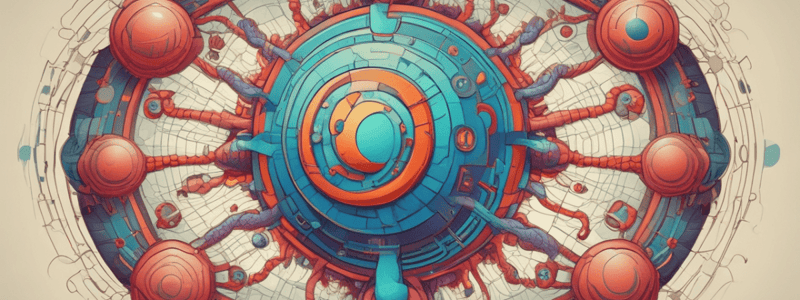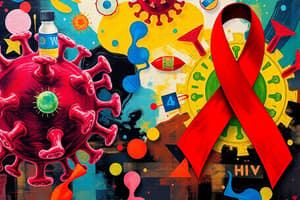Podcast
Questions and Answers
What type of virus is a retrovirus?
What type of virus is a retrovirus?
- Enveloped DNA virus
- Non-enveloped RNA virus
- Double-stranded DNA virus
- Single-stranded RNA virus (correct)
How does the retrovirus HIV enter the cell?
How does the retrovirus HIV enter the cell?
- Through lytic replication
- Through lysogenic replication
- Through direct fusion (correct)
- Through receptor-mediated endocytosis
What is the function of the protein reverse transcriptase?
What is the function of the protein reverse transcriptase?
- To replicate DNA
- To reverse transcribe RNA into DNA (correct)
- To transcribe DNA into RNA
- To translate RNA into protein
What is the product of reverse transcription?
What is the product of reverse transcription?
What is the direction of reading during reverse transcription?
What is the direction of reading during reverse transcription?
What is the purpose of the uncoating step in retroviral replication?
What is the purpose of the uncoating step in retroviral replication?
How many special proteins are carried by the retrovirus inside its envelope?
How many special proteins are carried by the retrovirus inside its envelope?
What is the name of the final product of reverse transcription?
What is the name of the final product of reverse transcription?
What is the purpose of integrase in the HIV replication cycle?
What is the purpose of integrase in the HIV replication cycle?
What happens to the RNA strand after integrase clips off the 3' ends?
What happens to the RNA strand after integrase clips off the 3' ends?
What is the term for the integrated viral DNA in the host genome?
What is the term for the integrated viral DNA in the host genome?
What is the function of the protease in the HIV replication cycle?
What is the function of the protease in the HIV replication cycle?
What is unique about the provirus stage compared to the regular lysogenic cycle?
What is unique about the provirus stage compared to the regular lysogenic cycle?
What happens to the viral mRNA after it exits the nucleus?
What happens to the viral mRNA after it exits the nucleus?
What is the term for the viruses that have not yet matured and are still missing their envelope?
What is the term for the viruses that have not yet matured and are still missing their envelope?
What happens to the immature viruses before they infect other cells?
What happens to the immature viruses before they infect other cells?
What is the purpose of the retrovirus replication cycle?
What is the purpose of the retrovirus replication cycle?
What is unique about the HIV replication cycle compared to traditional replication?
What is unique about the HIV replication cycle compared to traditional replication?
Study Notes
Retroviruses
- Retroviruses are a special case of viruses that don't fit into the lytic or lysogenic categories.
- They are enveloped, single-stranded RNA viruses that carry three special proteins.
Entry into the Cell
- Retroviruses enter the cell through direct fusion.
- After entry, the nucleocapsid undergoes uncoating, releasing the proteins and RNA.
Reverse Transcription
- The red protein, reverse transcriptase, reads the RNA from 5' to 3' end and forms complementary DNA (cDNA).
- Reverse transcriptase works again on the RNA to make another cDNA strand, which recombines with the first cDNA strand to form a double-stranded DNA.
Integration
- The blue protein, integrase, clips off the 3' ends of the DNA strands, forming sticky ends.
- Integrase integrates the viral DNA into the host's DNA.
- The viral DNA is now part of the host's genome, known as the provirus stage.
Transcription and Translation
- The host cell transcribes the viral DNA into viral mRNA, which exits the nucleus.
- The viral mRNA is translated into proteins, including the capsid proteins, reverse transcriptase, integrase, and protease.
Assembly and Budding
- The newly formed proteins and RNA self-assemble into new viruses, minus the envelope.
- These immature viruses bud off from the host cell, taking a piece of the membrane with them.
- The resulting viruses are still immature and require maturation.
Maturation
- The green protein, protease, cleaves the proteins to make them fully functional.
- This maturation process occurs before the virus infects another cell and starts the replication cycle again.
Retrovirus Replication
- Retrovirus replication is a unique process that combines elements of both lysogenic and lytic cycles.
- It involves reverse transcription, integration, transcription, translation, assembly, budding, and maturation.
Studying That Suits You
Use AI to generate personalized quizzes and flashcards to suit your learning preferences.
Description
Explore the special case of viral replication, retroviruses, and learn about their distinct features that set them apart from other viruses.




